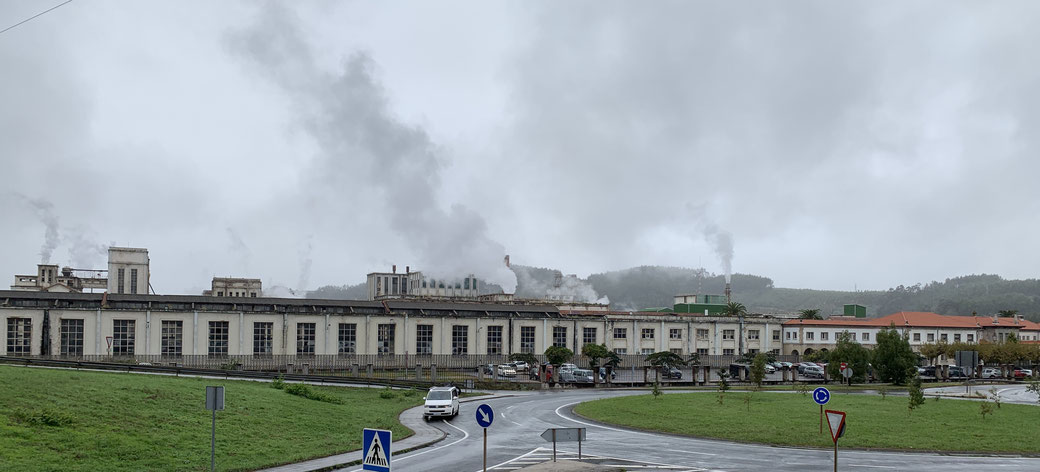
This is exactly how I always imagined wintering in Spain: Dry and warm...
I have always read in various travel reports that travelers, far from home, miss the seasons and especially spring and autumn. - Sounds good, I thought. - But what does it look like in real travel?
The rain drumming on our roof wakes us up early in the morning. It accompanies us throughout the day. Torgit has a sore throat and I have a cold. But we dope ourselves up with ginger. - Today we drive via Torrelavega towards Comillas. Cantabria reminds me a little of my home in the Bergisches Land. The landscape is hilly to mountainous, it looks very green and it rains too. But here you can clearly feel that the economic crisis has hit this region harder. Coming from the Basque Country, a clear change is noticeable. - Our path is repeatedly lined with ruined buildings. The industry looks visibly outdated. Livestock farming, fishing and tourism seem to be the pillars of the economy.
We see ourselves as a pillar of the economy and do a bit of tourism - Once we arrive in Comillas, we drive to the beach. We have breakfast in the van with the windshield wipers running. As there is no end in sight to the rain, I take off my shirt and go for a walk by the sea. But the looks on the faces of the few tourists in parkas clearly tell me that a naked upper body is not appropriate in this place, especially in this weather.
Speaking of befitting one's rank, you can literally feel that the Spanish royal family spent their summer vacation here at the end of the 19th century. The whole of Comillas looks a little sophisticated. You can sense that various architects wanted to leave and have left their mark in the Modernisme style. - I find it particularly exciting that what was once considered modern now exudes a glamorous, somewhat old-fashioned charm. - What will the generations after us think of the Bauhaus architecture that is currently so fashionable?
In unserer Reise in die Vergangenheit, besuchen wir erst einmal den Friedhof, mit seinem über dem Eingang wachenden Engel. Hier sind wir ganz für uns allein. – Schon der Name: Cementerio Ruta Modernista, hat Glanz oder? – Wenn man schon begraben sein muss, dann ist dieses Fleckchen, mit freier Sicht auf Meer und das „Monument to the Marquis de Comillas“, sicher kein ganz schlechter Platz. Ebenfalls im Blick steht das „Casa del Duque de Almodóvar del Río“, sowie die päpstliche Universität Comillas.
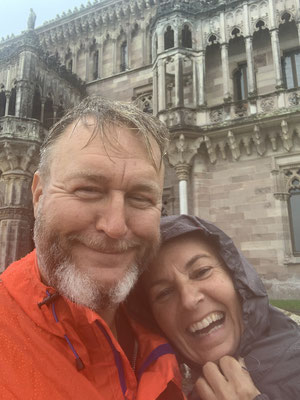
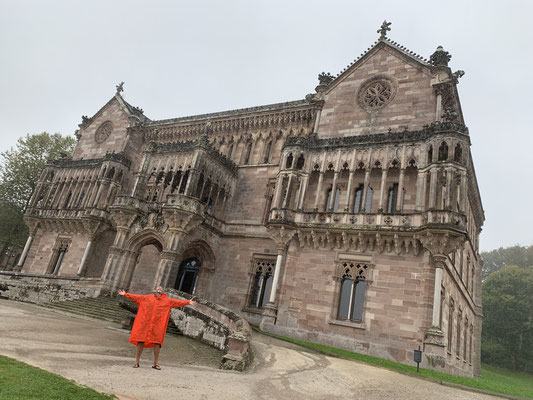
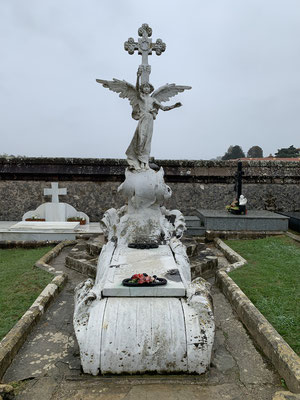
Next, we discover the palace of Sobrellano. Despite the rain, we decide to take a few steps up. The building, built in neo-Gothic style, impresses with its color contrasts. I try to blend in with my rain cape. Even in the pattering rain, this place has a charm all of its own.
Gibt es in Comillas noch mehr zu entdecken? Wir googeln ein wenig. – Entsprechend begeistert wollen wir uns noch das Landhaus „El Capricho“ von Gaudí ansehen. Das Navi zeigt uns zwei Wege. Angeblich gibt es zwei Routen. Wir versuchen unser Glück. Doch bereits die erste Route macht uns skeptisch. Der Weg wird immer schmaler und schlechter. – Hoffentlich kommt uns hier kein Auto entgegen. – Plötzlich sehen wir im Regen zwei Rückleuchten. Vor uns steht ein Fahrzeug und versucht zu wenden. Der Grund, eine Baustelle. Auch für uns bedeutet dies, langsam zurück setzen um möglichst zu wenden. Plötzlich lande ich fast mit einem Reifen im Graben. In letzter Sekunde habe ich die Handbremse gezogen. Jetzt ganz, ganz langsam wieder anfahren. Doch es geht gut. In der nächsten Serpentine gelingt es uns zu wenden. – Also die andere Route. Doch auch diese stellt sich als schwierig heraus. Zuerst geht es von der anderen Seite auf den Berg, zweimal muss ich aufgrund von Gegenverkehr zurück setzen. Dann wird die Straße immer schmaler und führt durch kleine Gassen. Am Ende einer Gasse scheint diese einen neunzig Grad-Winkel zu machen. Aus diesem setzt langsam ein PKW zurück. Das Capricho liegt in einer Sackgasse. Es gilt wieder zurückzusetzen, um eine Möglichkeit zum Wenden zu suchen. Inzwischen ist ein PKW hinter uns. Auch dieser versucht zu wenden und fährt sich dabei erst einmal in der Fassade eines Hauses fest. Über uns hören wir die spanischen Verwünschungen einer Anwohnerin. Jetzt verstehen wir auch das Schild „solo para residentes“. Unser Versuch zu wenden dauert seine Zeit. Vor-zurück, vor-zurück, ein paar Pflanzkübel umstellen und weiter, vor-zurück. Nach einigen Anläufen sind wir wieder frei und froh, dass Hector ohne Blessuren davon gekommen ist. – Wie würde unser Freund Uwe sagen? „Da ist es sicher auch noch schön , wenn ich nicht da war“ – So sehen wir das nun mit „El Capricho“. War eine Mords Gaudí.
We prefer to go to San Vicente de la Barquera. Camping el rosal is located between two beaches that are considered surfing hotspots.
Ich parke Hector mit direktem Blick auf die Bucht. Doch Torgit kommt mit einem Veto um die Ecke. „Warum gerade ich mal wieder so dicht an den Abgrund (zwei Meter Böschung) ran müsste und nicht, wie jeder normal parken könnte?“ – Entsprechend in meinem Ego angekratzt, parke ich um. Kaum stehen wir, wird der von mir angedachte Platz, von ein paar Surfern belegt.- Auf der anderen Seite werden wir auch noch eingekeilt.
So much for that. - Torgit then realized it too.
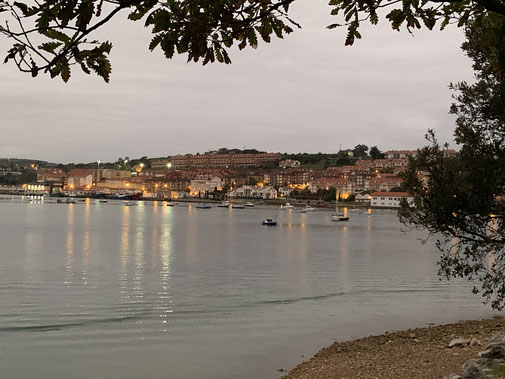
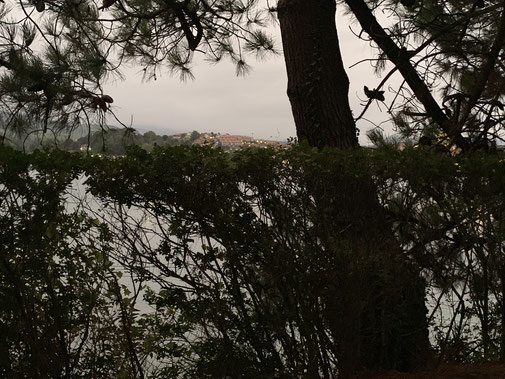
Hector’s Erkenntnis des Tages: „Man muss nicht immer im Mittelpunkt stehen, man darf auch mal sitzen“.
*PS: We don't so much miss the seasons. - What we miss is variety in our food. Anyone who knows us also knows our motto: Food makes you happy. - The vegetables in France were great. But the selection of sausage, cheese and above all bread seems to be unique in Germany. Torgit loves Spain. But her relationship with the French baguette was already disturbed. The local pan blanco doesn't make it any better, but...
Torgit approaches this issue differently, but no less emphatically. She writes a public letter directly to Spain:
„Liebes Spanien,
I've always liked you very much and we've spent many wonderful times together. I think I was 5 years old when we met. It would almost have been the first and last time if my father hadn't pulled me out of the sea again, into which the wave had dragged me while I was playing on the beach. - I got to know and love your cultural side during the school trip to Barcelona. - You gave me access to Spanish artists. - The Mallorca package vacation with Doris was the big wide world back then - two weeks in summer, for which you saved the whole year. I've loved Palma ever since - the family vacations on the Costa de la Luz, with fine golden sand, were Atlantic and always very beautiful. - With the round trip through Andalusia, you completely wowed me. I had pippi in my eyes in the Alhambra. So incredibly beautiful!
But now we have a problem. After 3 weeks in France, I was already over the baguette. Even though it was so incredibly delicious. Especially this one, for which I felt like I was the 20th person in the queue in the alley in this tiny bakery in a small village that we happened to pass by and whose name I've forgotten again, while the organ played so beautifully in the little church next door. So I had time to enjoy the market around me with its amusing range of everything from mattresses to slatted frames. But, as I said, this was in France.
Es geht fast nichts über ein gutes Brot. Allerdings sind wir Deutschen in Sachen Brot sehr verwöhnt, besonders durch die große Auswahl. Da fällt es mir schwer wochenlang das gleiche Brot zu essen. Und nun soll ich auch hier weiter immer nur dieses eine Brot essen? Damit käme ich ja vielleicht noch klar, wenn dieses Brot mir in Form von Pintxos serviert wird wie in Bilbao. Mit einem leckeren Txakoli. Aber dieses Ding, das ich hier im Supermarkt kaufe, und das Hector so verkrümelt, dass mein weltbester Ehrmann schlechte Laune bekommt, geht gar nicht. Also, gibt dir mal ein bisschen Mühe, sonst werden dein Pan Blanco und ich keine Freunde. In froher Erwartung, Torgit“

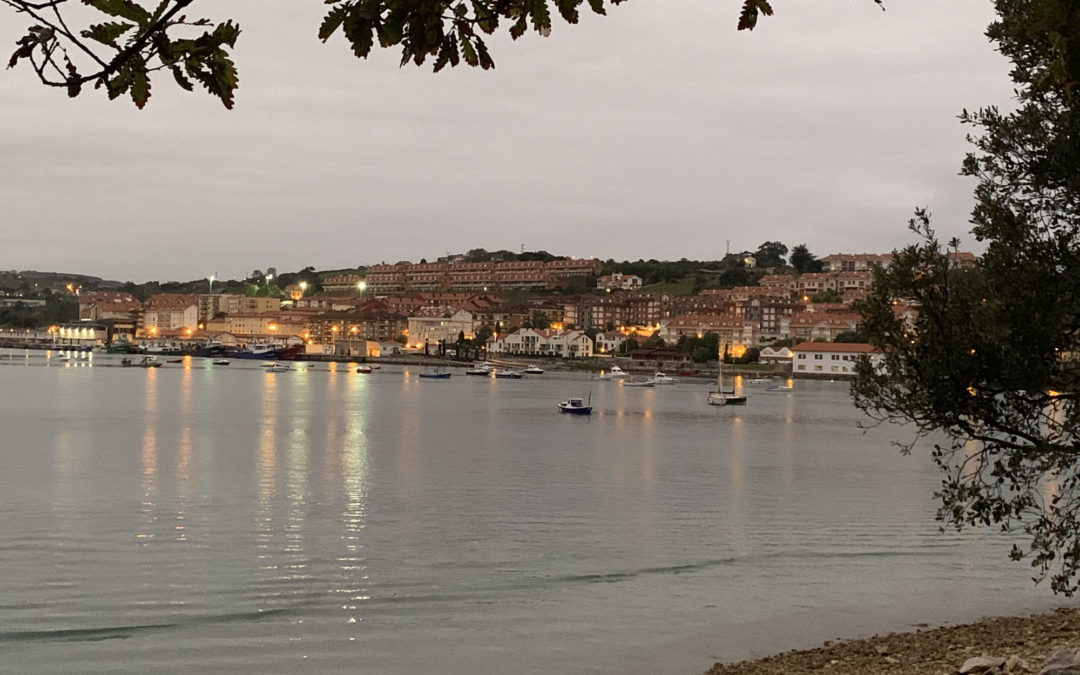
Recent Comments